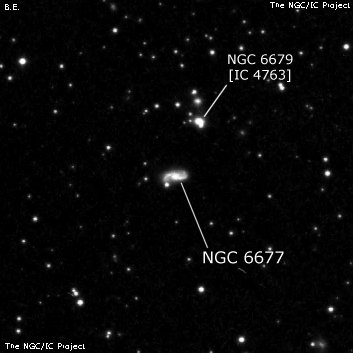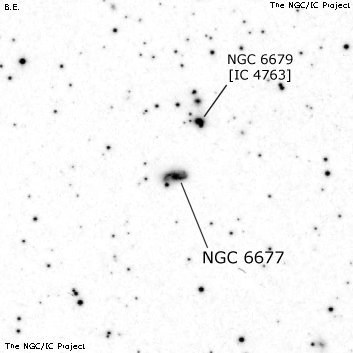NGC/IC Project Restoration Effort
(This is a very very beta version)
NGC6677


Basic Information
Location and Magnitude
Right Ascension: 18:33:30.4
Declination: +67:8:13
Constellation: DRA
Visual Magnitude: 13.1
Historic Information
Discoverer: Swift L.
Year of discovery: 1885
Discovery aperture: 16.0
Observational
Summary description: vF, vS, bet * v close ___DREYER___ vF D *
Sub-type: C
Corwin's Notes
=====
NGC 6677 and 6679 = IC 4763. Malcolm and I have fussed over this field for
several years now, and have been unable to come to a consensus. So here is my
take on the area.
The two brightest galaxies here -- Malcolm's objects "A" and "B" -- were seen
by Swift, Bigourdan, and Howe. (Kobold also has an observation of NGC 6677 in
the Strassburg Annals, Vol. 3, 1909, but his comparison star has a high proper
motion which makes the derivation of an accurate position more difficult.) I
agree with Malcolm that A must be NGC 6677, but am pretty well convinced that
B is NGC 6679 = IC 4763. Here's why:
As I always do for identification problems, I determined as accurate a
position as I can for every object bearing on an identity question. In this
case, this meant reducing Bigourdan's micrometric observations, and digging
positions out of the Guide Star Catalogue. Here are the results for Malcolm's
three objects (positions are for the equinox 1950.0):
Galaxy NGC/IC RA Dec Source Notes
A N6677: 18 33 39.20 +67 04 09.8 GSC
18 33 38.83 +67 04 11.3 Big 5 Sept 1891 only
18 33 40 +67 04.1 Howe
B N6679:=I4763 18 33 33.29 +67 05 47.1 GSC
18 33 33.58 +67 05 44.8 Big
18 33 35 +67 05.7 Howe
C --- 18 33 34.36 +67 06 21.8 GSC
Notice that I have used Bigourdan's observations only from the night of 5
Sept 1891 for NGC 6677. His observations on 25 June 1897 refer to the star
southeast of the galaxy. I also suspect that his comparison star (BD +66 1115
= GSC 4227-00549) has a relatively large proper motion as there is a
systematic offset of +0.24 sec and -7.8 arcsec between his positions and the
GSC positions for all the objects for which he used this star as a comparison.
I've corrected his positions in the table above for these offsets.
The excellent agreement between Bigourdan's, Howe's, and the GSC positions
convinces me that the two micrometric observations from each of the early
observers do indeed refer to Malcolm's objects A and B. Furthermore, their
descriptions also make sense -- and agree with Swift's -- if we note one
additional fact: object B is in fact a close double galaxy. Object C is more
than 30 arcsec north of B, which puts it much too far away to be part of the
object that Howe measured as NGC 6679: "This is a nebulous D * of mags 12.5,
distance 5 arcsec, [position] angle 60 deg." Bigourdan's description of it as
a double star, one that he could not resolve at 344X, also points to the close
pair as the actual NGC 6679 -- and adds support to the evidence from his
measured position that the pair is equal to Big 333 = IC 4763 (it is, of
course, clear that Bigourdan himself realized this).
All of this evidence, combined with Swift's own descriptions (in his papers 1,
3, and 9) seem to me to pin down the identifications without much doubt. I've
not taken Swift's own positions into account as we know that they are not very
good. In this case, Howe has noted that Swift's declination for N6679 in the
NGC is out by 8.5 arcmin. Swift corrected this by 10 arcmin when he finally
published the observation in AN 3004, but by then, the damage had been done.
Having said all of that, I urge you to read Malcolm's unravelling of the field
-- he comes to a different conclusion and might be right. But the agreement
of the positions and descriptions as I've laid them out above strongly suggest
to me that the identifications I've adopted are probably right. As usual in
these cases, however, I've put colons on the NGC numbers.
Steve's Notes
=====
NGC 6677
48" (10/22/11): fairly bright, moderately large, elongated 3:1 ~E-W, 0.9'x0.3', broad concentration with a slightly brighter core. A mag 14.5 star is just south of the eastern end. NGC 6679 lies 1.7' NNW. This galaxy is identified as IC 4763 in UGC, CGCG and PGC.
24" (8/27/14): fairly faint, fairly small, elongated 5:2 WNW-ESE, very weak concentration, ~40"x16". A mag 14.5 star is barely off the SE end.
17.5" (6/11/88): fairly faint, small, very elongated WNW-ESE. A mag 14 star is off the SE end 18" from center. Forms a close pair with NGC 6679 1.7' NNW.



